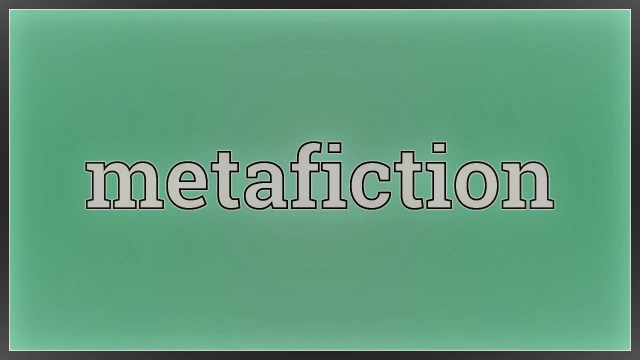
Metafiction is a captivating literary device that allows authors to explore the nature of storytelling and the relationship between fiction and reality. By self-consciously reflecting on its own form, metafiction challenges readers to reconsider their assumptions about narrative, authorship, and the act of reading itself. This expanded discussion will delve deeper into the definition of metafiction, its historical evolution, key characteristics, notable examples, and its significance in contemporary literature. Additionally, we will explore how metafiction shapes reader engagement and its implications for understanding the complexities of modern narratives.
Understanding Metafiction
Definition of Metafiction
Metafiction refers to a form of fiction that self-consciously addresses its own status as a work of fiction. This genre often blurs the lines between the narrative and the author’s commentary on that narrative, prompting readers to reflect on the processes of writing, reading, and interpretation. Metafiction can manifest in various ways, from direct authorial intrusions to complex narrative structures that disrupt the flow of the story. Essentially, metafiction invites readers to become aware of the conventions of storytelling and the artifice involved in the creation of narratives.
Historical Context
While elements of metafiction can be found in earlier literary works, the term gained prominence in the 20th century, particularly with the rise of postmodern literature. This period was characterized by a growing skepticism towards grand narratives and the notion of objective truth. Authors began to experiment with narrative techniques, questioning the nature of reality, representation, and the role of the author. The emergence of metafiction can be seen as a response to the changing cultural landscape, reflecting the complexities of contemporary life and the subjective nature of experience.
Early Examples of Metafiction
Before the term “metafiction” was coined, various authors employed self-referential techniques. For instance, Miguel de Cervantes’ “Don Quixote” (1605) features a protagonist who is aware of his fictional status, leading to humorous and thought-provoking moments. Similarly, Laurence Sterne’s “Tristram Shandy” (1759) employs digressions and authorial commentary, challenging the conventions of narrative structure. These early examples laid the groundwork for the metafictional explorations that would flourish in the 20th century.
Key Characteristics of Metafiction
Metafiction is characterized by several key features that distinguish it from traditional narrative forms:
1. Self-Referentiality
Metafiction often includes references to itself as a work of fiction. This self-referentiality can take various forms, such as characters acknowledging their fictional status or the author commenting on the act of writing. By drawing attention to its own construction, metafiction invites readers to question the nature of storytelling and the boundaries between fiction and reality knowledge.
2. Playfulness
Many metafictional works employ a playful tone, using humor and irony to engage readers. This playfulness serves to highlight the absurdities of storytelling and the conventions of literature. Authors often use wit and satire to critique literary tropes, inviting readers to reflect on their own expectations and assumptions.
3. Fragmentation
Metafiction frequently features fragmented narratives, nonlinear timelines, or shifts in perspective. This fragmentation reflects the complexities of reality and the limitations of traditional storytelling. By disrupting linear narratives, metafiction encourages readers to engage with the text on a deeper level, considering the connections between different elements of the story.
4. Intertextuality
Intertextuality is a hallmark of metafiction, as it often engages with other texts, drawing on literary traditions, genres, and conventions. This intertextuality invites readers to recognize the connections between different works and the broader literary landscape. By referencing other texts, metafictional works create a rich tapestry of meaning, encouraging readers to explore the relationships between various narratives.
5. Authorial Intrusion
In metafiction, authors may directly address the reader, interrupt the narrative flow, or insert themselves into the story. This authorial intrusion emphasizes the constructed nature of the narrative and the author’s role in shaping the story. By breaking the fourth wall, authors invite readers to consider the relationship between the storyteller and the audience, fostering a sense of intimacy and engagement.
Notable Examples of Metafiction
1. “If on a Winter’s Night a Traveler” by Italo Calvino
Calvino’s novel is a quintessential example of metafiction. The narrative follows a reader attempting to read a book titled “If on a Winter’s Night a Traveler,” only to be interrupted by various incomplete stories. The novel explores the act of reading and the relationship between the reader and the text, inviting readers to reflect on their own experiences with literature. Calvino’s playful narrative structure and self-referential commentary make this work a landmark in metafiction.
2. “The French Lieutenant’s Woman” by John Fowles
In this novel, Fowles employs metafictional techniques by directly addressing the reader and commenting on the narrative choices he makes. The author frequently interrupts the story to discuss the characters’ motivations and the implications of the Victorian setting, blurring the lines between fiction and reality. Fowles’ exploration of free will and determinism adds depth to the metafictional elements, inviting readers to question the nature of storytelling.
3. “Slaughterhouse-Five” by Kurt Vonnegut
Vonnegut’s novel combines elements of science fiction with metafictional commentary. The protagonist, Billy Pilgrim, becomes “unstuck in time,” experiencing different moments of his life out of order. Vonnegut’s authorial voice intrudes throughout the narrative, reflecting on the nature of war, trauma, and the act of writing itself. By intertwining personal experiences with fictional elements, Vonnegut creates a powerful critique of war and the human condition.
4. “The Book Thief” by Markus Zusak
In “The Book Thief,” the narrator is Death, who provides commentary on the events of the story and reflects on the nature of storytelling. This unique perspective invites readers to consider the role of the narrator and the impact of narrative voice on the reader’s experience. Zusak’s use of metafiction enhances the emotional resonance of the story, reminding readers of the fragility of life and the power of words.
5. “House of Leaves” by Mark Z. Danielewski
Danielewski’s novel is a complex, multilayered work that challenges conventional narrative structures. The story revolves around a house that is larger on the inside than it is on the outside, and it features multiple narrators, footnotes, and unconventional formatting. This fragmentation and self-referentiality compel readers to actively engage with the text and question the nature of reality. Danielewski’s innovative approach to storytelling exemplifies the potential of metafiction to push the boundaries of literature.
The Significance of Metafiction
Challenging Traditional Narratives
Metafiction challenges the conventions of traditional storytelling by inviting readers to question the reliability of narratives and the nature of truth. By drawing attention to the constructed nature of fiction, metafiction encourages readers to engage critically with texts and consider the implications of narrative choices. This critical engagement fosters a deeper understanding of the complexities of storytelling and the ways in which narratives shape our perceptions of reality.
Exploring the Nature of Reality
Metafiction often reflects the complexities of reality and the subjective nature of experience. By blurring the lines between fiction and reality, metafiction highlights the limitations of representation and the ways in which narratives shape our understanding of the world. This exploration of reality encourages readers to consider the impact of storytelling on their perceptions and beliefs, prompting them to question the nature of truth and representation.
Engaging Readers
Metafiction actively engages readers by inviting them to participate in the storytelling process. By breaking the fourth wall and addressing the reader directly, metafiction creates a dialogue between the text and its audience, fostering a deeper connection to the material. This engagement encourages readers to reflect on their own experiences with literature and the ways in which they interpret and construct meaning.
Reflecting Cultural Shifts
The rise of metafiction coincides with broader cultural shifts, including skepticism towards grand narratives and an increasing focus on individual perspectives. Metafiction reflects the complexities of contemporary life and the ways in which narratives shape our understanding of identity, culture, and society. As readers navigate a world filled with competing narratives, metafiction serves as a valuable tool for examining the stories that shape our lives.
The Role of Technology in Metafiction
In the digital age, the concept of metafiction has evolved further with the advent of new technologies. Online platforms, hypertext fiction, and interactive storytelling have expanded the possibilities for metafictional exploration. Authors can now engage readers in real-time, allowing for dynamic interactions that challenge traditional narrative forms. This evolution reflects the changing landscape of literature and the ways in which technology influences storytelling.
For instance, digital metafiction can incorporate multimedia elements, such as audio, video, and interactive graphics, creating a richer and more immersive reading experience. These innovations invite readers to actively participate in the narrative, blurring the boundaries between author and audience. As technology continues to shape the literary landscape, metafiction will likely evolve, offering new ways to explore the complexities of storytelling.
Reader Engagement and Interpretation
One of the most significant aspects of metafiction is its ability to foster active reader engagement. By drawing attention to the artifice of storytelling, metafiction encourages readers to become more critical and reflective in their reading practices. This engagement can take various forms:
1. Critical Thinking
Metafiction prompts readers to think critically about the narratives they encounter. By exposing the conventions of storytelling, metafiction encourages readers to question the reliability of narrators, the motivations of characters, and the underlying themes of the work. This critical engagement deepens the reader’s understanding of the text and fosters a more nuanced interpretation.
2. Self-Reflection
Metafiction invites readers to reflect on their own experiences with literature and the ways in which they construct meaning. By acknowledging the constructed nature of narratives, readers are encouraged to consider their own biases, assumptions, and interpretations. This self-reflection enhances the reading experience and fosters a deeper connection to the text.
3. Intertextual Connections
Metafiction often engages with other texts, inviting readers to recognize the intertextual relationships between different works. This engagement encourages readers to explore the broader literary landscape and consider how various narratives influence one another. By drawing on familiar tropes and conventions, metafiction creates a rich tapestry of meaning that enhances the reading experience.
4. Emotional Engagement
While metafiction is often associated with intellectual engagement, it can also evoke strong emotional responses. By exploring themes of identity, memory, and the human experience, metafictional works can resonate deeply with readers. This emotional engagement is often heightened by the self-reflexive nature of the narrative, as readers are invited to connect their own experiences to the themes explored in the text.
Conclusion
Metafiction is a powerful literary device that invites readers to reflect on the nature of storytelling and the relationship between fiction and reality. By self-consciously addressing its own constructedness, metafiction challenges traditional narrative forms and engages readers in a dialogue about the act of writing, reading, and interpretation.
Through its key characteristics—self-referentiality, playfulness, fragmentation, intertextuality, and authorial intrusion—metafiction enriches our understanding of literature and encourages critical engagement with texts. As we continue to explore the world of literature, the significance of metafiction reminds us that stories are not merely reflections of reality but complex constructs that shape our perceptions and experiences.
In a rapidly changing cultural landscape, metafiction serves as a vital tool for examining the narratives that shape our lives, inviting us to question the nature of truth, representation, and the power of storytelling itself. By fostering active reader engagement and encouraging critical reflection, metafiction not only transforms our understanding of literature but also enriches our experiences as readers in an increasingly complex world. As we navigate the myriad narratives that surround us, the lessons of metafiction will continue to resonate, guiding us in our exploration of the stories that define our existence.
Read Also About Scansion is the process of analyzing the meter, rhythm, and structure of a poem. It involves identifying the pattern of stressed and unstressed syllables in each line, helping to uncover the poem’s natural flow and emotional tone.
Related Posts
 Tata Krama Menarik untuk Kehidupan Sehari-hari Meta
Tata Krama Menarik untuk Kehidupan Sehari-hari Meta
 Apples Knowledge: How Understanding Their Benefits Can Improve Your Daily Diet
Apples Knowledge: How Understanding Their Benefits Can Improve Your Daily Diet
 Manfaat Menanam Pohon: Harmoni Hijau Bersama Alam
Manfaat Menanam Pohon: Harmoni Hijau Bersama Alam
 Dark Chocolate Knowledge: How It Supports Heart Health and Brain Function
Dark Chocolate Knowledge: How It Supports Heart Health and Brain Function




